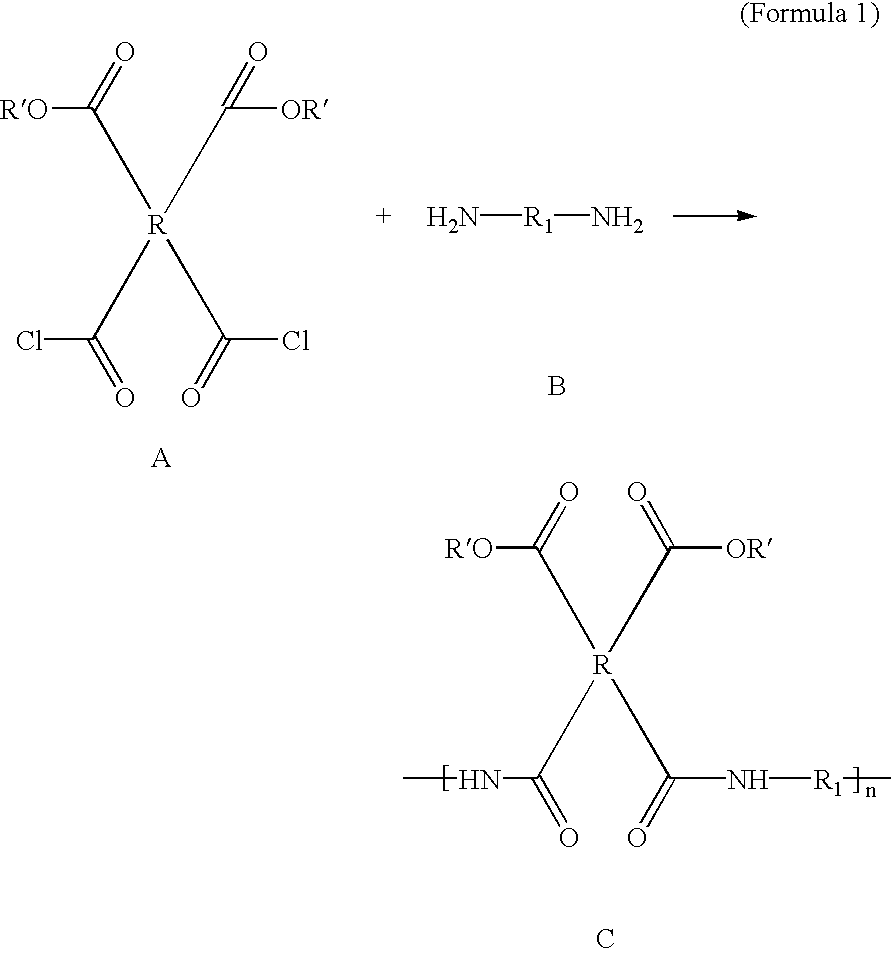Photosensitive polyimide precursor compositions
a polyimide and precursor technology, applied in the field of negative tone photosensitive polyimide precursors, can solve the problems of high film loss during development, damage or loss of relief image, adverse effects of photochemical cross linking reaction in producing insoluble products,
- Summary
- Abstract
- Description
- Claims
- Application Information
AI Technical Summary
Problems solved by technology
Method used
Image
Examples
example 2
A negative resist composition, prepared by mixing:
was rolled overnight to yield a clear resin solution and was then subjected to a pressure filtration through filters of pore width 0.2 microns. The resin solution was spin coated onto bare silicon and copper-coated silicon wafers and then dried on a hot plate for 7 minutes at 100.degree. C. In this way, 11 .mu.m thick films of uniform thickness were obtained on the wafers. The wafers were then exposed to monochromatic light with a wavelength of 365 nanometers using a Canon 3000i i-line stepper exposure tool. After exposure, the image was developed by rotating the wafers at 1000 rpm and then spraying the wafer with cyclopentanone for 35 seconds, followed by spraying the wafer s simultaneously with equal volumes of cyclopentanone and propylene glycol monomethylether acetate (PGMEA) for 10 seconds at 1000 rpm, and then spraying with pure PGMEA for 15 seconds. As a final step, the wafers were spun at 3000 rpm until dry. High quality reli...
example 3
A negative resist composition, prepared by mixing:
was rolled overnight to yield a clear resin solution and was then subjected to a pressure filtration. The resin solution was spin coated onto a silver-coated silicon wafer and then dried on a hot plate for 2 minutes at 110.degree. C. In this way, a 4.5 .mu.m thick film of uniform thickness were obtained on the wafer. The wafer was then exposed to broadband radiation using a Karl Suss MA 56 contact exposure tool at an energy dose of 300 mJ / cm.sup.2 . After exposure, the image was developed by rotating the wafer at 1000 rpm and then spraying the wafer with cyclopentanone for 10 seconds, followed by spraying the wafer simultaneously with equal volumes of cyclopentanone and propylene glycol monomethylether acetate (PGMEA) for 10 seconds at 1000 rpm, and then spraying with pure PGMEA for 10 seconds. As a final step, the wafers were spun at 3000 rpm until dry. High quality relief images were obtained on the silver coated wafer with a film ...
example 4
A negative resist composition, prepared by mixing:
was rolled overnight to yield a clear resin solution and was then subjected to a pressure filtration through filters of pore width 0.2 microns. The resin solution was spin coated onto bare silicon and copper-coated silicon wafers and the wafers were dried on a hot plate for 6 minutes at 105.degree. C. In this way, 15 to 17 .mu.m thick polymer layers of uniform thickness were obtained on the wafers. The wafers were then exposed to broadband radiation using a Karl Suss MA 56 contact exposure tool at an energy dose of 200 mJ / cm.sup.2 . After exposure, the image was developed by rotating the wafer at 1300 rpm and then spraying the wafer with QZ-3501 for 40 seconds, followed by spraying the wafer simultaneously with equal volumes of QZ-3501 and propylene glycol monomethylether acetate (PGMEA) for 15 seconds at 3000 rpm, and then spraying with pure PGMEA for 15 seconds at 1300 rpm. As a final step, the wafers were spun at 3000 rpm until dr...
PUM
| Property | Measurement | Unit |
|---|---|---|
| temperatures | aaaaa | aaaaa |
| wavelengths | aaaaa | aaaaa |
| temperatures | aaaaa | aaaaa |
Abstract
Description
Claims
Application Information
 Login to View More
Login to View More - R&D
- Intellectual Property
- Life Sciences
- Materials
- Tech Scout
- Unparalleled Data Quality
- Higher Quality Content
- 60% Fewer Hallucinations
Browse by: Latest US Patents, China's latest patents, Technical Efficacy Thesaurus, Application Domain, Technology Topic, Popular Technical Reports.
© 2025 PatSnap. All rights reserved.Legal|Privacy policy|Modern Slavery Act Transparency Statement|Sitemap|About US| Contact US: help@patsnap.com



